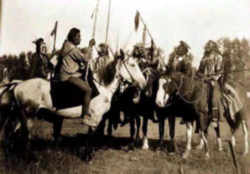


North Dakota Early History
First Early Inhabitants of North Dakota

Early history examines the archaeological record that tells the story of the first inhabitants of North Dakota. Learn about the prehistory and culture of the first early inhabitants, and what lessons it might teach us about the early history of North Dakota.
North Dakota First Early Inhabitants Timeline
- 9,500 BC - Paleo-Indian peoples initially occupied the Northern Plains, hunting mammoths, giant bison, and other mega-fauna. Mining of Knife River Flint, North Dakota's first export commodity, began in Dunn and Mercer Counties.
- 5,500 BC - Archaic peoples based their lifeways on hunting and gathering of essentially modern fauna since the previous era's mega-fauna were now extinct. The atlatl, a dart throwing device which drastically increased the range, effectiveness, and safety of hunting, came into use.
- 2500 BC - Gulf Formational Period with development of ceramics and pottery
- 700 BC - Ceramics were first used in North Dakota for cooking and food storage.
- 550-410 BC - Early Woodland peoples living along the James River in Southeastern North Dakota built a log and brush house. Charred grape chenopod (Goosefoot), and Marshelder seeds were found together in the house remains when they were excavated in A. D. 1985.
- 100 BC - Middle Woodland peoples began building burial mounds in North Dakota, including complex ceremonial centers. The bow and arrow were introduced during this period.
- AD 30 - Jamestown mounds, a complex burial and ceremonial site, were occupied.
- AD 900 - Late Woodland peoples used the bow and arrow extensively, produced ceramics resembling the later Plains Village wares, and gardened intensively.
- AD 950 - Plains Village peoples raised corn and other crops in sufficient quantities to store seed and trade for other goods. Seasonally occupied, permanent villages of earthlodges were built.
- AD 1200 - Jamestown mounds site was abandoned.
- AD 1200-1400 -
- A drought reduced agricultural production and fewer living sites were established on the open prairies. Plains Village peoples abandoned the lower James River area by AD 1300.
- 14th c. Scandinavians in North Dakota?
- AD 1600 - The Cheyenne, living in earthlodges, occupied the Sheyenne River valley; the Hidatsa moved west from Devils Lake to the Missouri; the Sioux moved onto the plains from the woodlands of Minnesota.
- 1000 AD - Woodland Period including the Hopewell cultures established along rivers in the Northeastern and Midwestern United States which included trade exchange systems and burial systems
- 1682 - Area claimed by Rene-Robert Cavelier, Sieur de La Salle (1643-1687) for France
Early History of Native Americans in North Dakota
The Indigenous People of North Dakota
The names of the North Dakota tribes included the Arapaho, Arikara, Cheyenne, Chippewa, Crow, Dakota, Hidatsa and Mandan
Before Euro-American settlement of the Northern Plains began in the 19th Century, the land had been occupied for many centuries. Archeological investigations document the presence of big game hunting cultures after the retreat of the continental glaciers about 10,000 years ago and later settlements of both hunting and gathering and farming peoples dating ca. 2000 BC to 1860. When the first white explorers arrived, distinct Indian groups existed in what is now North Dakota. These included the Dakota or Lakota nation (called "Sioux", or enemies by those who feared them), Assiniboine, Cheyenne, Mandan, Hidatsa, and Arikara. Groups of Chippewa (or Ojibway) moved into the northern Red River valley around 1800, and Cree, Blackfeet, and Crow frequented the western buffalo ranges.
These peoples represented two different adaptations to the plains environment. Nomadic groups depended primarily upon vast herds of American Bison for the necessities of life. When the horse was brought to the Northern Plains in the 18th Century, the lives of the Dakota, Assiniboine, and Cheyenne changed dramatically. These bands quickly adapted to the horse, and the new mobility enabled them to hunt with ease and consequently to live better than ever before. The horse became a hallmark of Plains cultures, and the images of these mounted Indians bequeathed an romantic image of power and strength that has survived in story, films, and songs. In contrast, the sedentary Mandan, Hidatsa, and Arikara lived in relatively permanent earthlodges near the Missouri River and supplemented produce from extensive gardens with hunting; their fortified villages became commercial centers that evolved into trading hubs during the fur trade of the 18th and 19th centuries.
Indians and Euro-Americans came into contact during the 18th Century. The first recorded visitor was La Verendrye, a French explorer who reached the Missouri River from Canada in 1738 while searching for a water route to the Pacific Ocean. Others followed, including La Verendrye's sons in 1742. However, most contact resulted from the Canadian fur trade until Meriwether Lewis and William Clark led the American "voyage of discovery" up the Missouri from St, Louis in 1804.





